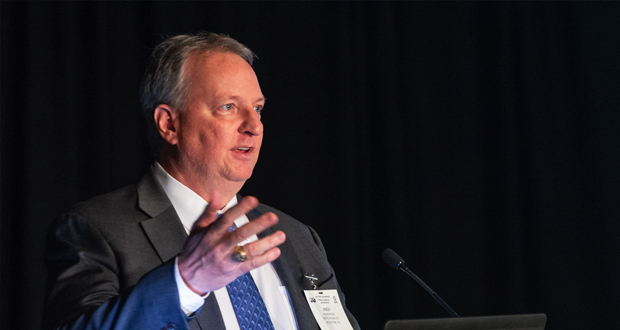Patterson-UTI’s Hendricks: Industry to remain focused on cost efficiency despite growth projections

By Stephen Whitfield, Associate Editor
While oil prices have been hitting multi-year highs in recent weeks following Russia’s invasion of Ukraine – highlighting the world’s continued need for hydrocarbons – sustained triple-digit oil price may not necessarily be a good thing for the industry, said William Andrew “Andy” Hendricks, President and CEO of Patterson-UTI. Speaking at the opening session of the 2022 IADC/SPE International Drilling Conference in Galveston, Texas, on 8 March, Mr Hendricks questioned whether $120 oil or higher “could push the Western countries into a recession.”
Overall, however, Mr Hendricks noted his current optimism for the recovery that the industry is seeing. He cited the International Energy Agency’s forecast that global oil demand will increase by 3.3 million bbl/day this year, moving up from 96.4 million bbl/day in 2021 to 99.7 million bbl/day in 2022. More specifically for rig sector, he also pointed to Wells Fargo’s forecasts for a 20% year-on-year increase in rig count this year and a similar increase in 2023. The forecast called for North American rig count to increase by 26% year-on-year from 2021 to 2022 and for international rig count to go up 15%. The Permian Basin will continue to be the key driver of rig activity in North America, making up nearly 25% of global rig count in 2022.
He also noted that WTI had been trading between $70-80/bbl even before geopolitical factors pushed prices above $100/bbl, so it’s clear the industry was headed for growth regardless. “I’m really upbeat about where we are in energy today,” Mr Hendricks said at the conference. “As we’ve worked our way through this COVID mess, we’re finally moving into an uptick… Given where oil price is expected to trade in the next few years, there’s certainly room to expand. If you thought at one time that you were going to transition to learning how to put up windmills or install solar panels, I’ve got a story for you: You’re going to be busy for the next couple of years. This is positive progress.”
Amid the recovery, however, the industry should take note of some key structural changes that have taken place during the last downturn, Mr Hendricks said. First, companies are facing increased pressure from investors to boost shareholder returns, rather than spend additional CAPEX on growth. “We have 300 E&Ps working with at least one drilling rig in the US. Oil prices are up to an economic level where somebody can make money if they want to try to make money,” he said. “If you’re a public company in this space, though, you’re now under pressure from investors to minimize your growth and return cash to shareholders. So that minimized growth means that the US is not going to ramp up production like it did before, even though demand is at a new peak. We are going to grow activity in the US in 2022 and 2023, but probably not to the extent that we did before.”
Second, the increased focus on cost will remain, Mr Hendricks said, because of inflation. Costs have risen not only for goods but for labor, as well. At Patterson-UTI, while the company has trimmed its costs to the point where there is “no more cost that you can strip out,” the daily operating cost of a rig has increased from just under $15,000 in 2018 to just over $15,000 in 2022. Because it’s become increasingly difficult to find labor, Patterson-UTI has had to incentivize its remaining personnel to stay on board through compensation increases.
While high labor costs are “just the reality” of the current economic environment, Mr Hendricks said pressure from operators and investors to keep costs low will force drilling contractors to look to for new ways to generate greater efficiencies.
“We will all continue to take costs out of the system, but it’s not going to come from how we operate a drilling rig,” Mr Hendricks said. “We’re going to continue working on technology: How can we improve the well construction process? How can we improve the completion process? How do we improve our processes while keeping them safe at the same time?”




